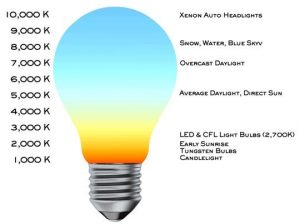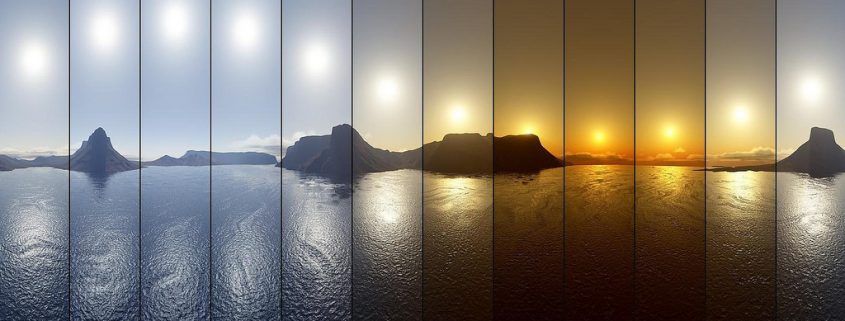Colour Temperature and Our Visual Environment
Light is what sets the tone for our visual environment. Through lighting spaces and architecture, objects and materials become visible, creating an aesthetically pleasing effect to the eye and adding a particular ambiance to an area.
When it comes to illuminating an area there are three types of lighting to consider:
- Ambient lighting – light that provides every day comfort lighting
- Accent lighting – light that focuses on a specific point or object
- Task lighting – light that illuminates an area used for specific tasks
RGB ( Red/Green/Blue ) LEDs – There are many scholarly articles that have shown that colours can influence our mood, behavior, likes, dislikes and also our decisions. Colours send signals to the brain that are both subtle and complex affecting the way we process information. Different shades of colour can create varying reactions. Some can be appealing or eye-catching, where others can be inviting, comforting or diverting. Colourful lighting adds a personal touch, setting the ambiance for each space.
Therefore, the way an area is perceived depends strongly on how it is illuminated. For instance, are soft and modest colours used, or bright and vibrant ones? Is the lighting direct or indirect? Is there a backlighting installation, this means the fixtures are not viewable but illuminating the room, or a direct view application, where there would be an eye-catching fixture?
For commercial use especially, colours play an essential role: they inspire, persuade and sell through their affective and suggestive attributes. They communicate image and influence behavior in a retail store environment. They can stimulate and create emotions for a concert or other live event, or effect our mood and how we perceive things when dining at a restaurant. Colourful light can become the focus in and of itself, through elaborate light installations or as a part of a work of art.
White LEDs have undergone vast improvement over the last few years and can now cater to a diverse array of lighting scenarios. Whether it be architectural or commercial, hospitality or retail, the ambiance of an environment can be set by the colour temperatures of the surrounding light and in turn influence moods, perception, shopping behavior and concentration levels. The colour of light strongly influences the ambiance of an area as well as its presentation. White light, for instance, defines an area’s appearance by tuning the colour temperature and creating a clean atmosphere. If warmer colour temperatures are applied ranging between 2700K and 4000K, an area appears more inviting, creating a sense of intimacy and comfort. These tones can be applied well in recreational and hospitality areas such as restaurants and hotels as well as libraries, bookstores, clothing shops and exclusive cosmetics stores . Skin and fabric colours appear warmer and more richly saturated when shown under warm colour temperature. Just as rubies, pearls and gold are eloquently accentuated in these colour hues.
When colder colour temperatures are applied ranging between 5000K and 7000K, a more clean and crisp appearance of an area is created. These color tones are appropriate for museums, galleries, jewelry or high-tech electronics stores or other areas requiring precise visibility. Glass, diamonds and crystals as well as precious metals like silver and platinum reflect beautifully in these color settings. With the use of professional lighting control systems simple changes to an area’s ambiance according to the changing needs and intended purposes are enabled. Creativity in lighting design of spaces and areas knows no bounds and allows for individually tailored lighting concepts.
INDOOR LIGHTING
Without physically changing it, light can change the appearance of a space or area. Rooms are expanded and accentuated, creating links and separations from one area from another. The attention to specific details is drawn through the illumination of surfaces such as floors, walls, ceilings or structures. However, the perception of the surrounding is specifically influenced by the applied direction of light, the brightness as well as the light distribution. Surfaces and objects become visible and the focus of attention is drawn to them. The general perception of an area can be altered just by accentuating the ceiling, for instance. The general mood and ambiance of a room can be set by indirect lighting of plane surfaces, while specific structures such as stuccos and frescos can be spotlighted.
Retail:
At this point in time, the main objective of the design of retail spaces is to create a unique shopping experience for the customer. Even though interior design and arrangement of the retail space build the basis, light plays an essential role and covers varied functions: LED displays and general lighting designs attract attention, divide the room into different functional areas and support an optimal presentation of goods according to the shop concept. The created ambiance influences the mood and well-being of the customers and has a strong effect on their consumer behavior.
Restaurants:
Lighting is an important element in restaurant design as it not only characterizes the space and defines the ambiance, but also has an effect on people’s mood. Lighting can affect a person’s perception in such a way that it makes a room feel more intimate or expansive, friendly or hostile, calming or exciting. However, it is not only the intensity of the lighting that plays an important role. The quality of the lighting, applied light sources as well as the contrast of light levels in different areas contribute to the lighting design of the restaurant. For instance, a busy cafeteria would need a bright ambient light for easy guidance through the room, an elegant restaurant, on the other hand, should use more subdued lighting schemes to encourage a comfortable dining atmosphere. In restaurants, direct lighting should be avoided in the dining area, as it distracts the perception. However, indirect lighting creates not only a comfortable atmosphere but eye-catching effects.
Museums:
Light has an enormous influence on both perception of spaces and artwork and can help to create an emotional response of the observer. The sole purpose of museum lighting is to create optimal conditions for viewing objects. Furthermore, it is important to also pay close attention to the general conditions of the area such as visual comfort, suitable light for orientation and movement as well as the ease of visual adaption to the differing light levels required. Light schemes vary, geared toward the characteristics of the art on display. Clear white tones are suitable for preserving original colors. A tuning of colour temperature can make a statement if the area is perceived bright and sterile (cold temperatures) or warm and inviting (warmer temperatures).
Clubs / Events:
The creative application of light and its interaction with people have a significant effect on any event. Light supports the theme of the event and emphasizes its concept. Varied dynamic lighting effects attract attention, bring a sense of awe to the audience and support the emotional ambiance of the event. Creating a certain ambiance has become easier and more modern. Where once previously candlelight and dimmed lighting scenarios were used, we find now a multitude of colours, designs and effects. Event-lighting aims at matched color-schemes to create intensive and dramatic effects, contrary to the simple accentuation of spaces.
OUTDOOR LIGHTING
For a long period of time simple functional lighting of outdoor areas was common place but now the illumination of buildings, facades and objects have become a growing interest. Light directly influences our visual environment. It not only by creates eye-catching architectural and entertaining environments but also defines the desired mood and atmosphere of an area. Outdoor lighting refers to the illumination of architecture, including academic/institutional, corporate, hospitality, monumental structures, residential, retail/entertainment and site/facade lighting projects, among others. The direction of light and light distribution has a significant influence on how architecture is viewed. The scope of design possibilities ranges from subtle illuminations of laminar surfaces over detailed accentuated structure to elaborate lighting design concepts (e.g. usage of whole facades for display function). The lighting concept will vary from color, brightness and direction of the light and has to be adapted to each type of surface, condition and intent of illumination. Especially for outdoor installation. High-power LEDs are recommended for usage, as their bright light output creates rich wall washing effects. Media facades have become increasingly popular. Large-scale display screens are firm landmarks of the skyline of many big cities. Lighting applications continue to become more and more creative, replacing conventional LED screens with more elaborate installation concepts. At this point in time, whole buildings are used for display, becoming gigantic screens for communication purposes.



